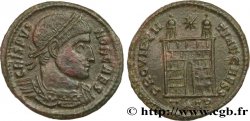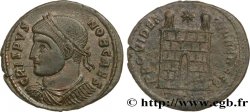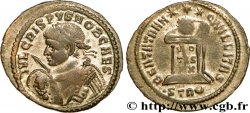v45_0795 - CRISPO Centenionalis ou nummus
MONNAIES 45 (2010)
Prezzo di inizio : 1 900.00 €
Valutazione : 2 800.00 €
lotto invenduto
Prezzo di inizio : 1 900.00 €
Valutazione : 2 800.00 €
lotto invenduto
Tipo : Centenionalis ou nummus
Data: 321
Nome della officina / città: Trèves
Metallo : rame
Diametro : 20 mm
Asse di coniazione : 6 h.
Peso : 2,52 g.
Grado di rarità : R3
Officine: 2e
Emission: 6e
Commenti sullo stato di conservazione:
Exemplaire sur un flan mince très large, parfaitement centré des deux côtés avec les grènetis complets. Portrait extraordinaire tout à fait exceptionnel avec un bouclier orné. Frappe légèrement molle au revers. Belle patine grise avec des reflets dorés. Conserve une partie de son brillant de frappe
N° nelle opere di riferimento :
Pedigree :
Cet exemplaire provient de la collection P. L.
Diritto
Titolatura diritto : IVL CRISPVS NOB CAES.
Descrittivo diritto : Buste lauré et cuirassé de Crispus césar à gauche, vu de trois quarts en avant, tenant la lance sur l’épaule de la main droite et le bouclier de la main gauche (F*1 var).
Traduzione diritto : “Iulius Crispus Nobilissimus Cæsar”, (Jules Crispus très noble césar).
Rovescio
Titolatura rovescio : BEATA TRAN-QVILLITAS/ VOT/IS/ XX/ -|-// .STR(CROISSANT).
Descrittivo rovescio : Autel inscrit surmonté d'un globe et de trois étoiles.
Traduzione rovescio : “Beata Tranquillitas/ Votis vicennalibus”, (L'Heureuse tranquillité/ Vœux pour le vingtième anniversaire de règne ).
Commento
Poids très léger. Avec l’intégralité de son argenture superficielle. Grand buste héroïque. Rubans de type 3 aux extrémités bouletées. Épaulière cloutée. Ptéryges larges. Bouclier avec umbo central orné d’un buste de Méduse de face. le buste semble aussi orné d’un arc ou d’un motif décoratif qui court le long du buste et dont le bois passe transversalement sur le buste. Au revers, le globe n’est pas visible et nous avons une cassure de coin qui traverse la légende de l’autel. Ce type est l’un des plus rares pour l’ensemble des “Beata”. Deux exemplaires sont actuellement recensés, le premier au musée historique de Bâle. le second faisait partie de la trouvaille d’Ermsdorf (FMRL. I), p. 247-264, pl. XV qui contenait plus de 10.000 nummi entre 307 et 340 et se trouve aujourd’hui conservée au musée du Grand Duché Luxembourg . Même coin de droit que l’exemplaire du RMBT, pl. XVI, n° 196. C’est le troisième exemplaire publié.
Very light weight. With all its surface silvering. Large heroic bust. Type 3 ribbons with pelleted ends. Studded shoulder guard. Wide pteryges. Shield with central umbo decorated with a bust of Medusa facing forward. The bust also seems to be decorated with an arc or decorative motif that runs the length of the bust and whose wood passes transversely over the bust. On the reverse, the globe is not visible and we have a die break that crosses the legend of the altar. This type is one of the rarest for the whole of the “Beata”. Two examples are currently listed, the first in the Historical Museum of Basel. The second was part of the Ermsdorf find (FMRL. I), p. 247-264, pl. XV which contained more than 10,000 nummi between 307 and 340 and is today preserved in the Museum of the Grand Duchy of Luxembourg. Same obverse die as the example of the RMBT, pl. XVI, no. 196. This is the third example published
Very light weight. With all its surface silvering. Large heroic bust. Type 3 ribbons with pelleted ends. Studded shoulder guard. Wide pteryges. Shield with central umbo decorated with a bust of Medusa facing forward. The bust also seems to be decorated with an arc or decorative motif that runs the length of the bust and whose wood passes transversely over the bust. On the reverse, the globe is not visible and we have a die break that crosses the legend of the altar. This type is one of the rarest for the whole of the “Beata”. Two examples are currently listed, the first in the Historical Museum of Basel. The second was part of the Ermsdorf find (FMRL. I), p. 247-264, pl. XV which contained more than 10,000 nummi between 307 and 340 and is today preserved in the Museum of the Grand Duchy of Luxembourg. Same obverse die as the example of the RMBT, pl. XVI, no. 196. This is the third example published








 Segnalare un errore
Segnalare un errore Stampate la pagina
Stampate la pagina Condividi mia selezione
Condividi mia selezione Fai una domanda
Fai una domanda Consegnare / vendere
Consegnare / vendere
 Descrittivo
Descrittivo










